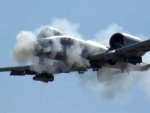What about letting the Marines have them? Our pilots probably do more CAS than all the rest put together.
A legitimate question that deserves a legitimate answer: Runways.
The USMC is our expeditionary force. Light on its feet and quick to the party. Because of this, USMC does most of its CAS with VTOL/STOL aircraft. Yes, they have plenty of F/A-18's and yes they get used for CAS. But they have to be launched from supercarriers or from a hard surface runway, which means that they're either not operating in an expeditionary role, or they are flying a fairly long distance to the target on every sortie, since putting thousands of USN and USMC personnel and their ship in harm's way to support a few dozen guys in a battle on land is generally regarded as a bad idea.
Flying 500 miles to the target in a fast mover isn't that big a deal - it just costs fuel and adds two hours to the mission. By comparison, the sweet spot for a warthog is about 250 KIAS with a declared cruise of 300 knots - not night and day faster than a blackhawk, and quite comparable with an Osprey. So the two hour transit time for the F/A-18 turns into four hours for the warthog. That isn't exactly a force multiplier...
Fuel you burn getting to the target is fuel you can't spend loitering, which, along with the slow speed, is why the warthog is so good for CAS - it can hang out for hours hosing down anything that pops up to bother the guys on the ground.
Now these are all solvable problems (the Seabees have been solving them for most of a century now), and I think it's unfortunate that USMC didn't get to buy the warthog (presumably with probe-and-drogue refueling) in place of more A-6s back when both were in production.
But a Marine-ized warthog would, at least, need to be fitted out with carrier arresting gear, tougher landing gear, and the avionics that go with them, probably also some airframe strengthening to deal with carrier landings as well. It would be related to the USAF airplane, but would also be significantly different, probably with a somewhat reduced range/loiter time because of weight gain. Compare the performance of the USAF F-86 to the USN/USMC FJ-2 for the likely penalties associated with such a conversion.
For its part, USAF wanted to stick bigger engines on the warthog to get the max gross takeoff roll down below 7500 ft. That should tell you something...





